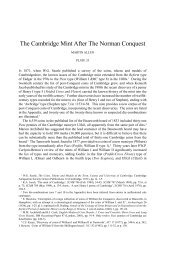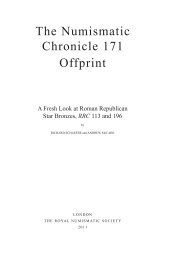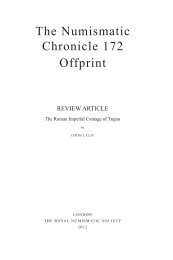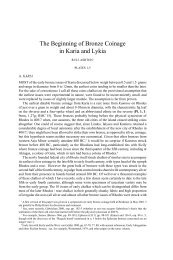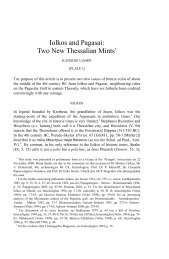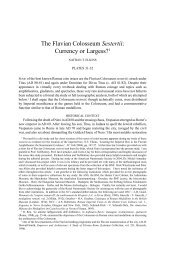The Numismatic Chronicle 171 Offprint - Royal Numismatic Society
The Numismatic Chronicle 171 Offprint - Royal Numismatic Society
The Numismatic Chronicle 171 Offprint - Royal Numismatic Society
Create successful ePaper yourself
Turn your PDF publications into a flip-book with our unique Google optimized e-Paper software.
THE CONFUCIAN MESSAGE ON VIETNAMESE COINS 367<br />
<strong>The</strong> Confucian Message on Vietnamese Coins<br />
A closer look at the Nguyễn dynasty’s large coins<br />
with moral maxims<br />
FRANÇOIS THIERRY<br />
IN THE COINAGE of the Nguyễn dynasty (1802–1945) there is a coherent group of<br />
large coins that bear moral maxims, which Lacroix called ‘royal medals in bronze’<br />
(médailles royales de bronze). 1 <strong>The</strong> coins were issued by three successive emperors:<br />
Thánh Tổ 聖祖 (Minh Mạng 明命 era, 1820–40); Hiến Tổ 憲祖 (Thiệu Trị 紹治 era,<br />
1841–7) and Dực Tông 翼宗 (Tự Đức 嗣德 era, 1848–83). 2 <strong>The</strong>y were large coins,<br />
cast in brass with a diameter of about 50 mm and with weights varying according<br />
to the reign: 26 to 28 grams during the Minh Mạng era, rising to 35 to 41 grams<br />
during the Thiệu Trị era, and reaching 35 to 50 grams during the Tự Đức era. <strong>The</strong><br />
Chinese maxims were almost all taken from the Confucian classics or from historical<br />
or literary works of that school of thought, but we cannot be sure that they were<br />
taken directly from the original texts or whether they were drawn from collections<br />
of quotations intended for candidates taking examinations. Although the edict of<br />
1837 says that they were ‘selected from the sacred and venerated books’ it must<br />
be said that they are often contractions, abbreviations or paraphrased versions, and<br />
sometimes even extrapolations, of the original texts. It is therefore highly likely<br />
that they were selected from manuals or commentaries published under the aegis of<br />
the Directorate of Education (Quốc tử giám 國子監). <strong>The</strong> criteria which prevailed<br />
in the selection of these maxims were deeply infl uenced by the dogmatic and rigid<br />
Confucianism which was the state ideology of the Nguyễn dynasty.<br />
On the whole, numismatists have not taken much interest in this aspect of the<br />
coinage. <strong>The</strong>re has even been some confusion as to which types were issued by<br />
which ruler. <strong>The</strong> Minh Mạng era decree cited by Schroeder includes a list of maxims<br />
on coins, but some of these were not used during this reign. Similarly, some unknown<br />
types appear in the Tự Đức era which are not mentioned in the sources.<br />
This study includes only those types for which there is a reliable illustration,<br />
rubbing or photograph. Types that appear in the various lists without illustrations<br />
1 This paper was originally submitted in French. I am grateful to Helen Wang for helping translate it<br />
into English.<br />
1 Lacroix, Numismatique annamite, pp. 163–5.<br />
2 Lacroix, nos 400, 401, 406, 407 bis –430, 450–481; Schroeder, pp. 206–214 and nos 128–167, 217–<br />
218, 311–319; AMM nos V60–V78, V132–V146, V210–V225; CMV nos 1515–1556, 1602–1632,<br />
1772–1838; CMVS nos 391–399, 422–433, 487–491; Barker, Historical cash coins of Viêt Nam, pp.<br />
268–9. Coins of this type (or similar) for the Gia Long, Kiến Phúc, Hàm Nghi, Đồng Khánh, Thành<br />
Thái and Duy Tân eras are fakes or fantasy pieces made in the 1960s and 1970s in South Vietnam for<br />
American collectors; for details, see Kemgpen ‘Palast Münzen des Kaisers Minh Mang’.



